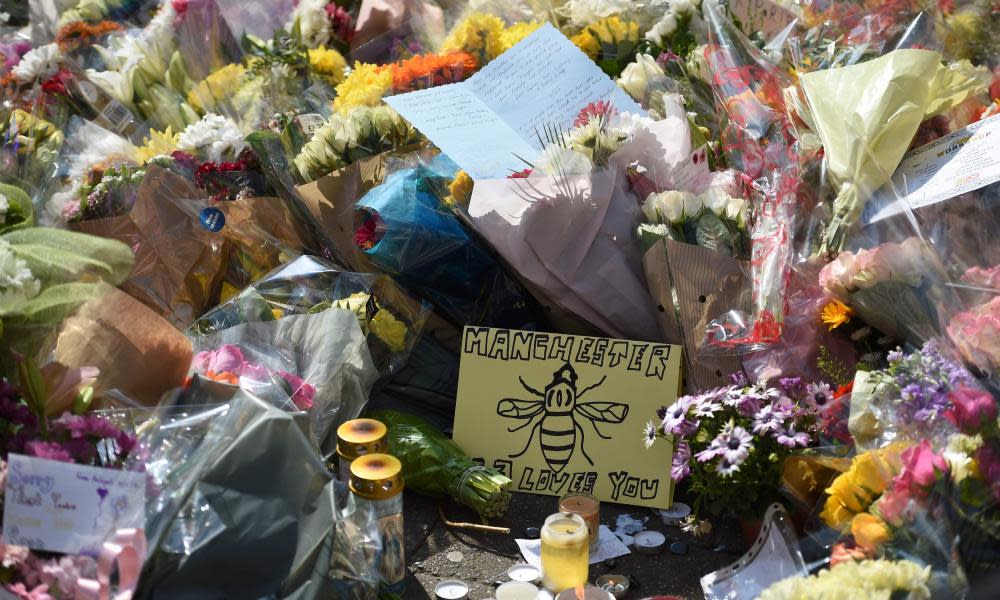Are journalists prying too far into grief? | Jane Martinson

Emma’s mother heard that her daughter had been caught up in a terrorist attack from the Sun newspaper while Emma (not her real name) was still in shock, a long way away, with a disconnected phone and her Facebook account hacked.
Four years on, watching children being asked what they had seen the morning after the terrorist attack in Manchester reminded Emma, who now works as a mental health professional, how the media had made her own experience worse. She said: “They kept asking me what injuries I’d seen, to add more ‘colour’. And all I could see was the pavement red with blood.”
When I was caught up in a terrorist incident 4yrs ago, the behaviour of UK media made the trauma much worse. They don't seem to have changed
— Em (@DrEm_79) May 23, 2017
The morning after the attack, Emma wrote a tweet that was retweeted more than 11,000 times. The thread described how she stopped being able to use her phone, how the emergency number at the hospital where she worked was called repeatedly by reporters and how notes were pushed through her letterbox – all of which she believed exacerbated the symptoms of post-traumatic stress.
JK Rowling called it a “thread for newspaper editors”.
Thread for newspaper editors 👇 https://t.co/xRNVzDSDyG
— J.K. Rowling (@jk_rowling) May 23, 2017
The increase in terror attacks has turned the spotlight on the media, who grapple with more information than ever in a more competitive market. From the journalists who find the survivors to the subeditors who write headlines to the picture editors who must wade through hundreds of horrific images to choose which ones best tell one of the most important stories of our age, reporting tragedy has never been easy and social media is making it harder.
Like most journalists, I believe asking difficult questions is a key part of the job. Like many who started on local newspapers, one of my first jobs was to knock on the door of a bereaved family and ask them to talk, in this case about the loss of a teenage boy. I’ll never forget the reaction of that family on a Merthyr Tydfil housing estate, who welcomed in the young reporter from the South Wales Echo to look at the family photo album and hear stories about his life.
The media, especially local media, provided a conduit for the victims’ grief, a way of paying tribute. Media can still do that and give such tributes a bigger audience. And yet, that compact is being stretched as never before, not just because today that family would have their own social media accounts, but also because the media’s own behaviour is being questioned more than ever.
The editors’ code of practice followed by most British newspapers states: “In cases involving personal grief or shock, enquiries and approaches must be made with sympathy and discretion and publication handled sensitively.”
Sympathy, discretion and sensitivity were not much in evidence following an interview in which a reporter asked difficult questions of a man who tried to help the youngest victim of the Manchester attack, eight-year-old Saffie Roussos. An interview in the Sun was cited in an article by MailOnline with a headline highlighting the fact that she had “cried for her mother”, the mother who is so seriously injured that no one yet knows whether she even knows her daughter is dead. Clause 4, governing intrusion into grief, can only be used to complain by those directly affected. Despite this, 30 people had used it to complain to press regulator Ipso within hours of the Mail tweet about the article, which was subsequently taken down.
Despite her experience, Emma sees a “purpose and place for media coverage”. Just days after surviving a terrorist attack, she appeared at a public event and a television crew asked her to talk. Having given in to requests from one local paper “just to make them stop”, Emma responded to the polite request from the TV crew because she wanted to say thank you to the supporters of the event. “But when they move on, it doesn’t stop for the people affected,” she said. “It carries on.”
The job of journalists is to tell the story, whether it’s difficult or not, and not necessarily to help the victims. Yet the consequences of acting callously, of refusing to take no for an answer, of hounding people suffering from grief, are great.
Several studies in recent years have suggested that one-off questioning can make post-traumatic stress disorder worse. Or, to use the jargon, “single session debriefing” for trauma victims is not particularly helpful.
But there are consequences for the media, too. Given the volume of information that can now be gleaned within minutes online, not just a potential victim’s name but their address and their mother’s address, the industry must remember its responsibilities to the people whose stories it tells, as well as its power to tell them.

 Yahoo News
Yahoo News 
